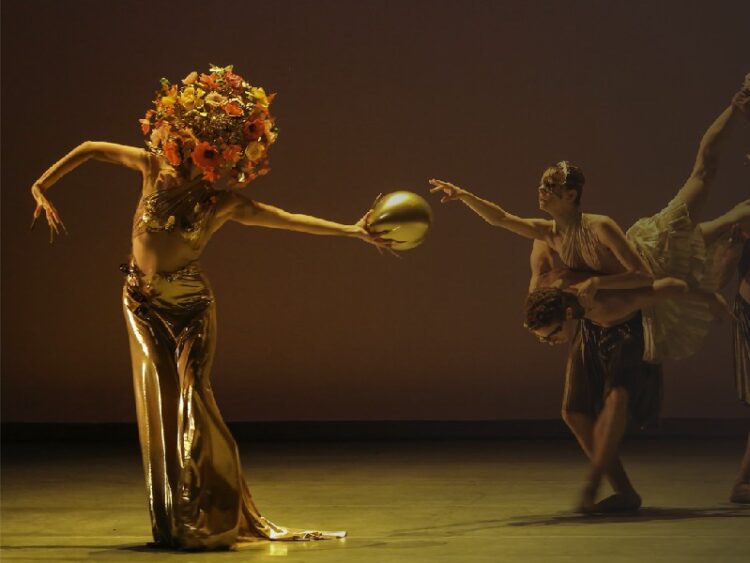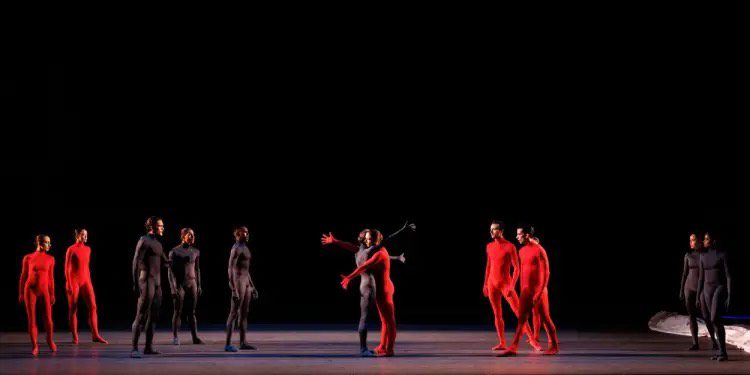A Contemporary Season-Closer for the Washington Ballet
By • June 20, 2024 0 901

The Washington Ballet closed out its 2023-24 season with contemporary flair. Titled “Beyond Boundaries,” the trio of ensemble pieces — presented over the last weekend in May in the Kennedy Center Eisenhower Theater — would have been at home in the NEXTsteps series launched by former TWB artistic director Julie Kent (now at Houston Ballet).
In fact, one of the works, Annabelle Lopez Ochoa’s “Delusional Beauty,” premiered as part of a NEXTsteps program in October of 2019. Lopez Ochoa — “not a rising star any longer … a star,” enthused TWB Artistic Director Edwaard Liang at a recent Georgetowner breakfast — served as guest-curator of “Beyond Boundaries.”
No one better understands the interpenetration of ballet and modern dance in recent years than the Amsterdam-based Lopez Ochoa, who danced with contemporary companies in The Hague and Rotterdam following her classical training. (Raised in Belgium, she is the daughter of a Belgian mother and a Colombian father.)
As Lopez Ochoa told the Washington Post’s Rebecca Ritzel in 2014, when she first choreographed for the Washington Ballet: “People dream away when dancers are on pointe shoes, because it’s so supernatural. It’s abstract. But contemporary dance reflects the society where we are today, more than a piece by Balanchine. It can be about themes, like loneliness. It’s much more raw, and the bodies of the dancers are more like us.”
The nine dancers in “Delusional Beauty” didn’t seem “more like us,” especially the Golden Figure. Danced at the May 25 matinee by TWB Studio Company member Misha Glouchkova in a gold harem costume, this creature had a flower bouquet instead of a head (designer: Mark Zappone). Lopez Ochoa, who often uses an image as her starting point, decided to bring Salvador Dalí’s “La femme à la tête de fleurs” to life, with a varied electronic score — eerie, pulsing, stormy, at times with the sound of wind or suggesting Asian or Spanish guitar music — by composers Aaron Martin, Christen Lien and Zoë Keating.
The 20-minute piece is set in a surrealistic garden; four women and four men — all in skirts, the men with bands across bare chests — dance around a weird tree and pick its fruit of gold balloons from branches that look like their bent arms. Meanwhile, the bouquet-headed goddess moves slowly in mysterious, flamenco-ish ways, displaying her extreme fingernails. At one point, Ayano Kimura and Gilles Delellio danced a duet to plucked music.
Another 20-minute piece, the world premiere of Houston Thomas’s “A Dancer’s Prayer,” opened the program. Nearly as otherworldly as “Delusional Beauty,” “A Dancer’s Prayer” was the most ballet-like of the three works, incorporating solos, pas de deux and dancing on pointe. As Lopez Ochoa writes of the Chicago-born Thomas, who studied at the Joffrey Ballet and the School of American Ballet: “His work is hyper-kinetic and deeply rooted in the classical ballet vocabulary.”
Elizabeth A. Coco’s spotlights-and-fog lighting plan framed an intricate ceremony under the night sky, with 11 dancers in black-and-silver costumes by Keto Dancewear moving to electronic music rich in drones, thumps and beats by Johannes Goldbach.
Layered into the score was a spoken “conceptual poem” by Skyler Maxey-Wert, a former dancer with the ballet company of the Semper Opera in Dresden, as were Goldbach and Thomas. An excerpt: “Just as the very essence of our universe flows through our veins and we see her reflected in ourselves, let us see the same reflection in the faces of our neighbor.”
The program’s 25-minute finale, “colōrem” by Chanel DaSilva, was a restaging of a 2022 work premiered by the Joffrey Ballet, which lent the costumes — sleeved-and-gloved single-color leotards — for the 14 dancers: six in red, six in gray, plus the pas-de-deux couple of Lope Lim in red and Tamako Miyazaki in gray.

From “colōrem” by Chanel DaSilva. Photo by xmbphotography. Courtesy The Washington Ballet.
Though the work’s seed images were politically charged photographs by Southern California photographer Tim Tadder that DaSilva saw on Instagram, “colōrem” tells a story of healing. The music, by Cristina Spinei, a Nashville-based Juilliard grad who specializes in music for dance, is elaborated minimalism — piano, vibraphone and fiddle (or their synthesized equivalents), plus various electronics — a good match for the minimalist visual palette.
From Tadder’s “provocative images of human forms, heads, bodies and hands, all painted in very bold colors … I settled on two colors, this bold, vibrant red that has so many emotions tied to it, and also this very stark metallic gray,” writes DaSilva, a Brooklyn native who earned a BFA at Juilliard, danced with Trey McIntyre Project and Lar Lubovitch Dance Company and in 2015 co-founded MOVE[NYC], “a leading-edge arts and social justice organization.”
Jets and Sharks? Terrapins and Buckeyes? Whoever they were, the bands of brothers and sisters alternately showed their stuff, entering, exiting, lining up and dividing, switching from the front of the stage to the back. A red light bathed the white-box set for a Red segment. In one of the most intriguing episodes, the Grays appeared to dance with their own shadows.
Neither group seemed held back by the other; it felt more like a Capulets-and-Montagues state of affairs. Eventually, Reds and Grays began to dance in bicolor formations. When the pas-de-deux couple returned, the dance — and the eye-opening, three-part program — concluded with a one-happy-family feeling.

